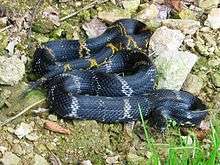Elaphe schrenckii
| Elaphe schrenckii | |
|---|---|
| Scientific classification | |
| Kingdom: | Animalia |
| Phylum: | Chordata |
| Class: | Reptilia |
| Order: | Squamata |
| Suborder: | Serpentes |
| Family: | Colubridae |
| Genus: | Elaphe |
| Species: | E. schrenckii |
| Binomial name | |
| Elaphe schrenckii (Strauch, 1873) | |
| Synonyms[1] | |
| |
Elaphe schrenckii is a nonvenomous colubrid snake species, which is endemic to Northeast Asia (China, Korea, Russia, Mongolia). Elaphe schrenckii is a relatively large colubrid.
Taxonomy
Elaphe schrenckii is very similar to the Korean rat snake, Elaphe anomala, which was once thought to be a subspecies of E. schrenckii and classified as Elaphe schrenckii anomala.
Etymology
The specific name, schrenckii, is in honor of zoologist Leopold von Schrenck.[2]
Common names for E. schrenckii include Amur rat snake, Manchurian black racer, Manchurian black water snake, Russian rat snake, Schrenck's rat snake, and Siberian rat snake. As one common name, Manchurian black water snake, suggests, E. schrenckii is an excellent swimmer, and it is also an excellent climber. The common name, Russian rat snake, is misleading as only a small portion of the geographic range of E. schrenckii is in Russia.
Description

Adults reach lengths of 140–180 cm. The northern, darker, most common variety is known to be more fearless, inquisitive & personable than its southern cousin, which is somewhat more nervous & shy.
Distribution and habitat
The species occurs in Russia and China, to the east to Chabarowsk in the Amur region, west to the Chingan mountains, and north to Manchuria (Northeastern China).[3] It has been reported from Chinese provinces of Jilin, Heilongjian, and the Quingyuan area of Liaoning. (Ji Daming e.a., 1985).[4]
In the Netherlands the species occurs as an exotic around Groningen airport near Eelde, where it was first seen in the mid nineteen nineties. Reportedly, pet snakes were released into the wild by someone who did not expect that they would survive the winter, but the snakes were hardier than expected, bred and the species is now gradually increase its range.[5]
As the name suggests, this species inhabits fairly moist biotopes. Forest clearings, scrub, farmland, hiding amongst cavities in trees, piles of stone or wood, and when threatened can flee up a tree or into the water. E. schrencki has been noted up to 6m high in trees. This species occurs up to 2000 meters altitude and can live in cooler areas than many other snakes.[6]
Feeding
It is a variety of rat snake that feeds primarily on small mammals, birds & bird eggs. It is often found in wetlands, but also found in a wide variety of mainly moist environments such as scrub land, farmland, river banks, swamp land, gardens, stones, log piles, forests and up in trees. The Manchurian Black Water Snake is a very good climber, found as high up in trees as 6 meters.
Conservation
The species has not been assessed by the IUCN but is on the China Species Red List with a classification of "Vulnerable VU A2a". It is an officially protected species in Russia and South Korea.
References
- ↑ "Elaphe schrenckii ". The Reptile Database. www.reptile-database.org.
- ↑ Beolens, Bo; Watkins, Michael; Grayson, Michael (2011). The Eponym Dictionary of Reptiles. Baltimore: Johns Hopkins University Press. xiii + 296 pp. ISBN 978-1-4214-0135-5. (Elaphe schrenckii, p. 238).
- ↑ Nikolski, A.M., Fauna of Russia and Adjacent Countries, Reptiles, Vol. II, Israel Progr. For Sc. Translations, Jerusalem, 1916.
- ↑ Ji Daming et al, Studies on Elaphe schrenki of China, Acta Herpetl, Sinica 4 (3): 239-246, 1985.
- ↑ Russische rattenslang gedijt goed in Eelde RTV Noord 20 februari 2016
- ↑ Petzold, H.G., Elaphe schrenki, Amurnatter, AT-Terrarienlex, 23 (2): 7, 1976.
Further reading
- Boulenger GA (1894). Catalogue of the Snakes in the British Museum (Natural History). Volume II., Containing the Conclusion of the Colubridæ Aglyphæ. London: Trustees of the British Museum (Natural History). (Taylor and Francis, printers). xi + 382 pp. + Plates I-XX. (Coluber schrenckii, pp. 48–49).
- Strauch A (1873). "Die Schlangen des russischen Reichs, in systematischer und zoogeographischer Beziehung ". Mémoires de l'Académie Impériale des Sciences de St.-Pétersbourg, Series 7, 21 (4): 1-288. (Elaphis schrenckii, new species, pp. 100–103). (in German and Latin).
- Mongolian Red List of Reptiles and Amphibians. Zoological Society of London, Regent’s Park, London, NW1 4RY, 2006
- Ratsnake Foundation - E. schrencki,2012